Deciphering Your Car'S Warning Indicators: What They Absolutely Signify
Deciphering Your Car'S Warning Indicators: What They Absolutely Signify
Blog Article
Short Article Developed By-Hartley Torres
When you're behind the wheel, those glowing caution lights on your dashboard can be a bit bewildering. Do you know what they're trying to tell you concerning your vehicle's wellness? Comprehending car detailing expert of these lights is vital for your safety and the durability of your lorry. So, the next time among those lights pops up, wouldn't you want to decipher its message properly and take the needed steps to address it?
Common Warning Lighting and Interpretations
Identify common warning lights in your car and recognize their definitions to ensure safe driving.
The most common warning lights include the check engine light, which signals concerns with the engine or exhausts system. If this light comes on, it's critical to have your car examined promptly.
The oil pressure cautioning light indicates reduced oil pressure, needing instant attention to avoid engine damages.
A blinking battery light may suggest a defective charging system, potentially leaving you stranded otherwise resolved.
The tire stress monitoring system (TPMS) light alerts you to reduced tire stress, influencing lorry stability and fuel effectiveness. Overlooking this might bring about dangerous driving conditions.
The abdominal light shows a trouble with the anti-lock braking system, endangering your ability to quit promptly in emergency situations.
Finally, the coolant temperature advising light warns of engine overheating, which can result in extreme damage if not settled promptly.
Comprehending great site will assist you address problems without delay and preserve safe driving problems.
Importance of Prompt Focus
Recognizing the common warning lights in your vehicle is only the first step; the importance of quickly resolving these cautions can not be emphasized enough to guarantee your safety when driving.
When a warning light illuminates on your control panel, it's your auto's method of interacting a possible issue that requires attention. Neglecting these warnings can cause much more severe troubles later on, endangering your security and potentially costing you more out of commission.
Motivate interest to advising lights can protect against breakdowns and crashes. For instance, a blinking check engine light might indicate a misfire that, if left neglected, might trigger damages to the catalytic converter. Addressing this without delay can conserve you from an expensive fixing.
In a similar way, a brake system warning light could signal low brake fluid or worn brake pads, essential components for your security when driving.
DIY Troubleshooting Tips
If you observe a warning light on your dashboard, there are a couple of do it yourself fixing tips you can attempt before seeking specialist aid.
The very first step is to consult your cars and truck's manual to recognize what the particular warning light shows. Sometimes the issue can be as simple as a loose gas cap activating the check engine light. Tightening up the gas cap might deal with the problem.
Another common issue is a reduced battery, which can set off various advising lights. Inspecting the battery links for deterioration and guaranteeing they're safe and secure might fix the problem.
If a warning light lingers, you can attempt resetting it by detaching the vehicle's battery for a few mins and then reconnecting it. Furthermore, examining your lorry's liquid levels, such as oil, coolant, and brake liquid, can help troubleshoot alerting lights related to these systems.
Verdict
Finally, understanding your auto's caution lights is vital for keeping your car running efficiently and safely. By immediately addressing these signals and recognizing what they indicate, you can avoid pricey repair services and possible break downs.
Keep in mind to consult your automobile's guidebook for particular details on each advising light and do something about it accordingly to make sure a hassle-free driving experience.
Remain informed, remain risk-free on the road!
